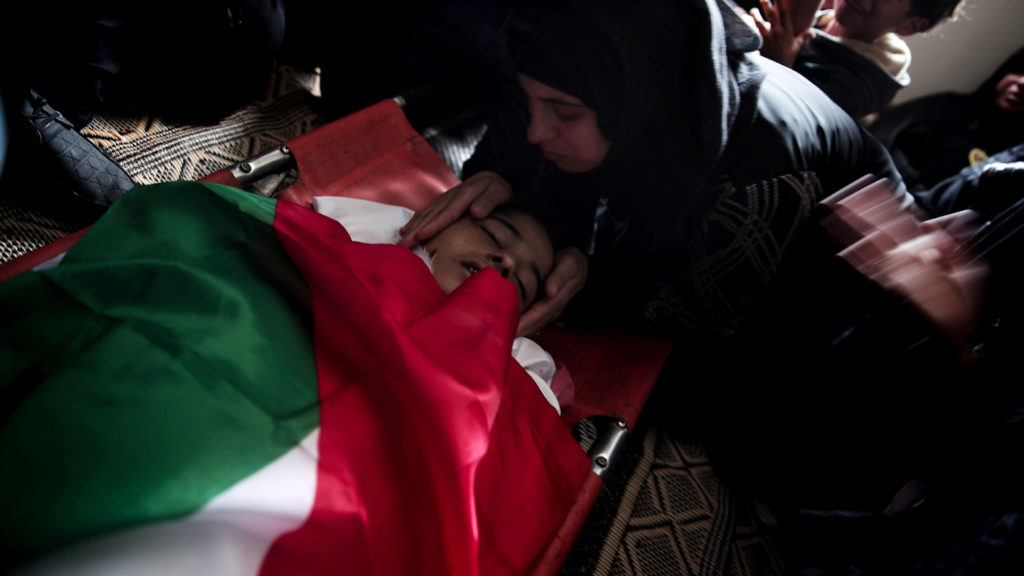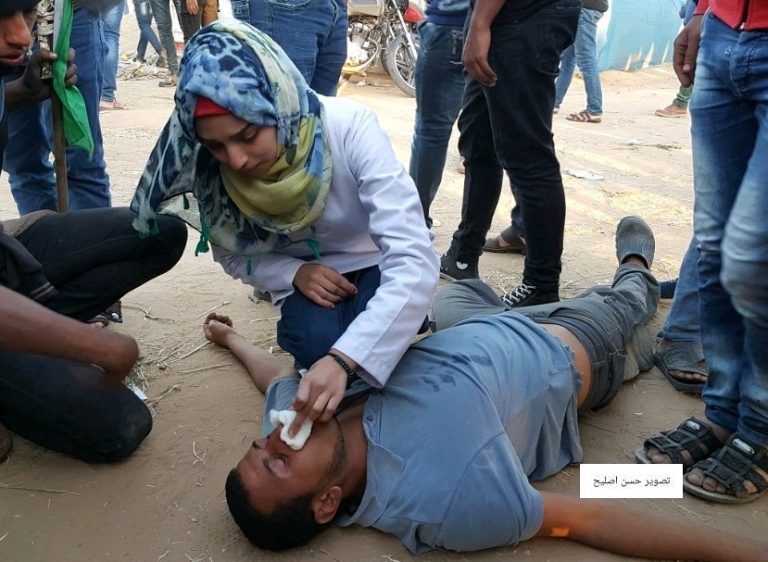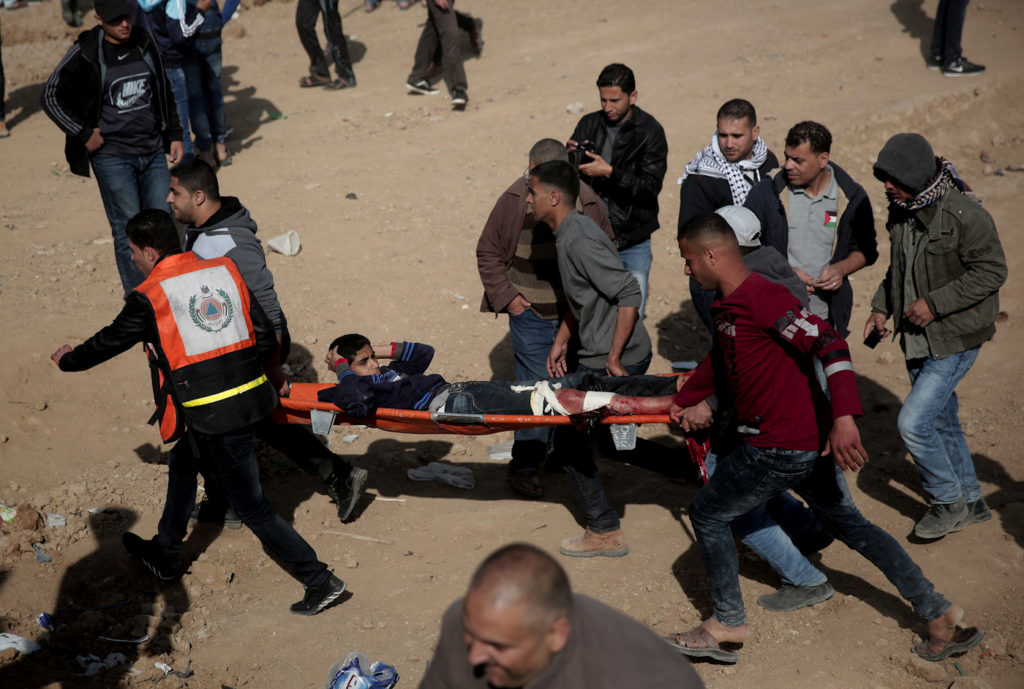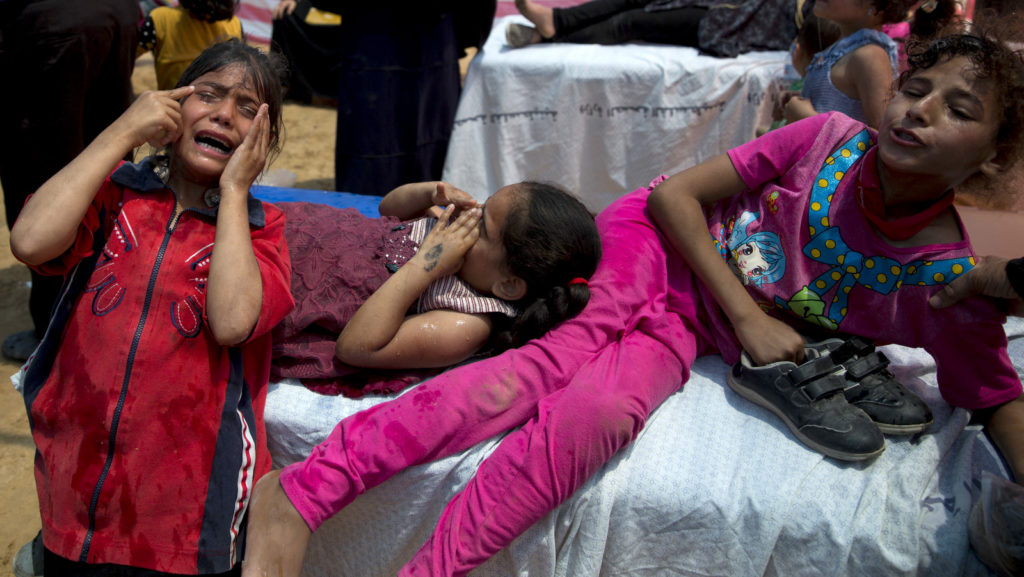A Peek into the Horrific Findings of the UN Report on Israel’s Massacre of Gaza Protesters
PALESTINE - ISRAEL, UNITED NATIONS, 11 Mar 2019
Robert Inlakesh – MintPress News
The commission found serious human rights violations that may constitute crimes against humanity and called on Israel to “Lift the blockade on Gaza with immediate effect.”

A relative reacts to the lifeless body 15-year old Palestinian boy, Azzam Hillal (Owidah), at the family home during his funeral in Khan Younis, southern Gaza Strip, April 28, 2018. The Palestinian Health Ministry in Gaza says a boy has died a day after being shot in the head by Israeli soldiers. Khalil Hamra | AP
8 Mar 2019 – The United Nations (UN) Human Rights Council have released a powerful report, on the Gaza ‘Great Return March’ demonstrations, stating that they have grounds to believe Israel committed International War Crimes against demonstrators during “large-scale civilian protests”.
The 22-page document has been condemned by the Israeli government, as there is talk of Israel being brought to the International Court of Justice and tried for war crimes and violations of International Law against demonstrations that “were civilian in nature”.
“The commission conducted 325 interviews and meetings with victims, witnesses, government officials and members of civil society, from all sides, and gathered more than 8,000 documents, including affidavits, medical reports, open source reports, social media content, written submissions and expert legal opinions, video and drone footage, and photographs.”

Razan al-Najjar, the 21 year old Gaza medic killed by an Israeli sniper on June 1, treating an injured man, undated photo from Palestine Live on twitter.
Here are the most important points concluded in the report:
- The commission found in the killings of 189 demonstrators between 30 March and 31 December 2018, 183 were killed with live ammunition, including 35 children, 3 health workers and 2 members of the Press. Only 29 of those killed were members of Palestinian armed groups.
- Only 4 Israeli snipers were lightly injured, none were killed by demonstrators.
- 23,313 Palestinian demonstrators were injured during the 2018 demonstrations, 6106 with live ammunition, “contributing to the highest toll of injuries recorded in the Occupied Palestinian Territory since 2005.
- On the killing of child demonstrators, the commission found “reasonable grounds to believe that Israeli snipers shot them intentionally, knowing that they were children”.
- On the killing of health workers, “the commission found reasonable grounds to believe that Israeli snipers intentionally shot health workers, despite seeing that they were clearly marked as such”.
- On the killings of journalists, “the commission found reasonable grounds to believe that Israeli snipers shot journalists intentionally, despite seeing that they were clearly marked as such”.
- The commission found that both male and female protestors were shot in the groin. The female victims told the commission they are now “unlikely to be able to have children”.
- The policy of the Israeli Minister of Defense, was to deny passage to any person injured during demonstrations, causing unnecessary deaths and life changing injuries.
- According to the commission, except in two possible cases, “the use of live ammunition by Israeli security forces against demonstrators was unlawful”.
- Israel used a “disproportionate use of force”.
- The “demonstrators were shot in violation of their right to life or of the principle of distinction under international humanitarian law”.
- The commission found “reasonable grounds to believe that the excessive use of force by Israeli security forces violated the rights” of thousands of demonstrators who were peaceful.
- The commission found “reasonable grounds” to believe that Israel violated “The Convention on the Rights of the Child”.
- “Violations of international law, such as those committed by Israeli security forces and set out in this report, give rise to State responsibility…”.
The commission found serious human rights violations that may constitute crimes against humanity and called on Israel to “Lift the blockade on Gaza with immediate effect.
The often repeated Israeli claims of the protests being inspired and organized by “Hamas terrorists”, were also addressed in the report, which stated that the demonstrations were inspired by the internet posts of 34-year-old Palestinian poet and journalist, Ahmed Abu Artema, with the demonstrations being organized by “A higher national committee and 12 subcommittees.”
The report went on to say, that “while the members of the committee held diverse political views, they stated that their unifying element was the principle that the march was to be “fully peaceful from beginning to end” and demonstrators would be unarmed”.
Activities such as the use of incendiary kites, cutting barbed wire or tire burning were organized by “self-declared” units. The report further states “the commission found no evidence to suggest that they were directed or coordinated by armed groups”.
The commission interviewed what it called an international journalist who said, “I have covered wars in Syria, Yemen, Libya. I have never seen anything like this. The slow methodical shooting. It was just shocking…”
The commission also noted that Israel refused to assist with the UN investigation and did not “cooperate or provide information.”
The following is a sample of the cases investigated by the commission.
March 30 demonstrations

Palestinian protesters carry a wounded youth who was shot by Israeli troops during a March 30, 2018 demonstration on the Gaza Israel border. Khalil Hamra | AP
Injury of 17 Mohammed Ajouri (17 years old)
“Israeli forces shot Mohammad, a student-athlete, in the back of his right leg as he gave onions to demonstrators to relieve tear-gas symptoms, approximately 300 m from the fence. His leg had to be amputated.”
The murder of Abdel Fatah Nabi (18 years old)
“Israeli forces killed Abed, from Beit Lahia, when they shot him in the back of the head as he ran, carrying a tyre, away from and about 400 m from the separation fence.”
The murder of Bader Sabagh (19 years old)
“Bader, from Jabaliya, was killed by Israeli forces when they shot him in the head as he stood smoking a cigarette 300 m from the separation fence.”
Injury and murder of schoolgirl (13 years old) and Marwan Qudieh (45 years old)
“Israeli forces injured a schoolgirl with bullet fragmentation. As she lay on the ground, four men attempted to evacuate her. The forces shot three of them, killing Marwan Qudieh (45) from Khuzaa village and injuring a potato seller and another man in the legs. One of the rescuers had to have a leg amputated.”
Injury of Alaa Dali (21 years old)
“Alaa, a member of the Palestinian cycling team, was shot by Israeli forces in the leg as he stood holding his bicycle, wearing his cycling kit, watching the demonstrations, approximately 300 m from the separation fence. His right leg had to be amputated, ending his cycling career.”
May 14 demonstration, seven children killed

Palestinian children suffering from teargas inhalation recover in a medical tent during a protest near Beit Lahiya, Gaza Strip, May 14, 2018. Dusan Vranic | AP
“On 14 May, Israeli security forces shot and killed seven children: a girl, Wisal Khalil (14), and six boys: Izzedine al-Samak (13); Said al-Kheir (15); Ahmad al-Sha’ar (15); Talal Matar (15); Saadi Abu Salah (16); and Ibrahim al-Zarqa (17).”
The murder of Mohammad Najar (33 years old)
“Israeli forces shot Mohammad, a naval police officer, in the chest, killing him, as he sat on a hill with a friend, around 500 m from the separation fence.”
The murder of Yasser Abu Naja (11 years old)
“On 29 June, Israeli forces killed Yasser from Khan Younis with a shot to the head as he was hiding with two friends behind a bin, approximately 200 m from the separation fence. The children had been chanting national slogans at Israeli forces.”
The murder of Nasser Mosabeh (11 years old)
“Nasser was from Khan Younis. On 28 September, Israeli forces shot him in the back of the head as he stood 250 m from the separation fence. He died the same day.”
The murder of Razan Al-Najar (20 years old)
“On 1 June, an Israeli sniper bullet hit Razan, of the Palestinian Medical Relief Society and who at the time was wearing a white paramedic vest and standing with other volunteer paramedics approximately 110 m from the separation fence, in the chest at the Khuzaa site, east of Khan Younis. She died in hospital.”
The murder of Yasser Murtaja (30 years old)
“On 6 April, Yasser, a journalist from Gaza City, was shot in the lower abdomen by Israeli forces at the Khan Younis site while he was filming the demonstrations for a documentary. He was wearing a blue helmet and a dark blue bulletproof vest clearly marked “Press”. He died the following day.”
Amputation of Abed Nofal (11 years old)
“On 17 April, Abed, a schoolboy from the Bureij refugee camp, was shot by Israeli forces while he was playing football near the separation fence. His leg had to be amputated.”
The extended version of the report is set to be released on March 18, 2019. The commission recommended that UN members consider imposing individual sanctions, such as travel bans or an asset freezes on those responsible.
______________________________________________
Robert Inlakesh is a journalist, political analyst and human rights activist who specializes in delivering insight into the geopolitical scene of the Middle East, specializing in the political and humanitarian situation in Palestine.
Republish our stories! MintPress News is licensed under a Creative Commons Attribution-NonCommercial-ShareAlike 3.0 International License.
Go to Original – mintpressnews.com
DISCLAIMER: The statements, views and opinions expressed in pieces republished here are solely those of the authors and do not necessarily represent those of TMS. In accordance with title 17 U.S.C. section 107, this material is distributed without profit to those who have expressed a prior interest in receiving the included information for research and educational purposes. TMS has no affiliation whatsoever with the originator of this article nor is TMS endorsed or sponsored by the originator. “GO TO ORIGINAL” links are provided as a convenience to our readers and allow for verification of authenticity. However, as originating pages are often updated by their originating host sites, the versions posted may not match the versions our readers view when clicking the “GO TO ORIGINAL” links. This site contains copyrighted material the use of which has not always been specifically authorized by the copyright owner. We are making such material available in our efforts to advance understanding of environmental, political, human rights, economic, democracy, scientific, and social justice issues, etc. We believe this constitutes a ‘fair use’ of any such copyrighted material as provided for in section 107 of the US Copyright Law. In accordance with Title 17 U.S.C. Section 107, the material on this site is distributed without profit to those who have expressed a prior interest in receiving the included information for research and educational purposes. For more information go to: http://www.law.cornell.edu/uscode/17/107.shtml. If you wish to use copyrighted material from this site for purposes of your own that go beyond ‘fair use’, you must obtain permission from the copyright owner.
Read more
Click here to go to the current weekly digest or pick another article:
PALESTINE - ISRAEL:
- Gaza Is Our Holocaust
- Israel Kills 9 Medics and Destroys Their Ambulances in Rafah
- The Sunday Recap: Horror Stories from Gaza and the West Bank
UNITED NATIONS: